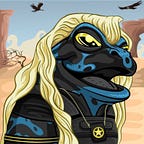You’ve heard about ICOs, IDOs, IPOs, and raising billions of dollars for blockchain startups — but have you heard of the DAO?
A decentralized autonomous organization (DAO), sometimes called a decentralized autonomous corporation (DAC), is an organization represented by rules encoded as a computer program that is transparent, controlled by the organization members, and not influenced by a central government. A DAO’s financial transaction record and program rules are maintained on a blockchain. (What Wikipedia says).
A DAO eliminates the need to involve a third party in a financial transaction, simplifying those transactions through smart contracts.
Unlike a traditional organization where it’s headed by a bunch of investors and shareholders and C suites in the holy name of hierarchy, a DAO eradicates that.
A DAO is managed collectively by users who can have a say in blockchain-based efforts, goals, strategy, and spending with no need for a ruler (CEO) or an executive team.
You see the freedom yeah?
To join a Dao you only need to buy its Crypto Currency/ Native token, so holding their crypto-asset gives you the ability to vote on proposals and updates, proportional to the amount the DAO holds.
Here is why a DAO is different from any Organization
- A core group of people came up with the concept.
- Completely visible framework
- No single person is in charge, and it can be verified at multiple points.
- Any DAO member can view any financial aspect of the firm without difficulty, making it publicly auditable.
- Changes to the code or protocol must be voted on in a transparent manner.
- DeFi, NFT, and utilitarian use cases can all be built into the system.
Let’s take a look at the types of Decentralized autonomous organization (DAO), sometimes called a decentralized autonomous corporation (DAC), is an organization represented by rules encoded as a computer program that is transparent, controlled by the organization members, and not influenced by a central government. A DAO’s financial transaction record and program rules are maintained on a blockchain. (What Wikipedia says).
A DAO eliminates the need to involve a third party in a financial transaction, simplifying those transactions through smart contracts.
Unlike a traditional organization where it’s headed by a bunch of investors and shareholders and C suites in the holy name of hierarchy, a DAO eradicates that.
A DAO is managed collectively by users who can have a say in blockchain-based efforts, goals, strategy, and spending with no need for a ruler (CEO) or an executive team.
You see the freedom yeah?
To join a Dao you only need to buy its Crypto Currency/ Native token, so holding their crypto-asset gives you the ability to vote on proposals and updates, proportional to the amount the DAO holds.
Here is why a DAO is different from any Organization
- A core group of people came up with the concept.
- Completely visible framework
- No single person is in charge, and it can be verified at multiple points.
- Any DAO member can view any financial aspect of the firm without difficulty, making it publicly auditable.
- Changes to the code or protocol must be voted on in a transparent manner.
- DeFi, NFT, and utilitarian use cases can all be built into the system.
Let’s take a look at the types of DAO
- Operating Systems DAOs –These are standalone platforms that allow organizations to create their own DAOs. Examples of projects include Syndicate and CW.
- Protocol DAOs — Rather than put every key decision in the hands of a small team of developers, Protocol DAOs use tokens as a voting metric to implement the protocol and financial changes. Examples of projects include Uniswap, Maker, Yearn, Synthetic, Curve, and more.
- Investment DAOs — This is the second-largest category of DAOs that supports capital pooling for various DeFi operations and investments. Examples of projects include theLAO, BitDAO, and more.
- Grants DAOs — Also known as philanthropy DAO More like decentralized venture capitalists with communities, where governance tokens are used to vote on capital allocation. The only difference is that allocations are made without the expectation of a financial return, unlike the investment DAO. Examples of projects include Audius Grants, MolochDAO, and more.
- Collector DAOs — Meant for NFTs and artists to support fractional or complete ownership of art and content. Examples of projects include Flamingo.
- Service DAOs — Talent hunting and acquisition model for agencies and individuals. Contributors also typically receive governance tokens that convey ownership in the DAO. Their clients consist of other crypto projects and protocols that need everything from software development to graphic design and marketing. Examples of projects include MetaverseDAO, DaoHaus, and more.
- Social DAOs — This intends to bring like-minded people together in online communities, coordinated around a token. Decentralized platform for interactions like social networking where users gain access to NFTs, News, and Parties that cannot be accessed by those who are not on the DAO. Key projects include Seed Club, FWB,BAYC and more.
- Media DAOs — This is more like a decentralized news aggregator that is transparent and works in the consumers’ common interest. Rather than rely on advertising-based revenue models, these DAOs use token incentives to reward producers and consumers for their time with an ownership stake in a given outlet. Examples include Mirror.
Deficiencies of DAOs
- Lack of legal/regulatory clarity.
- Lack of efficient coordination mechanisms.
- Lack of infrastructure.
- Smart contract, fragmentation, & sustainability risks.
- It is still in its infancy and requires a more critical perspective.
- Disputes could lead to a hard fork.
